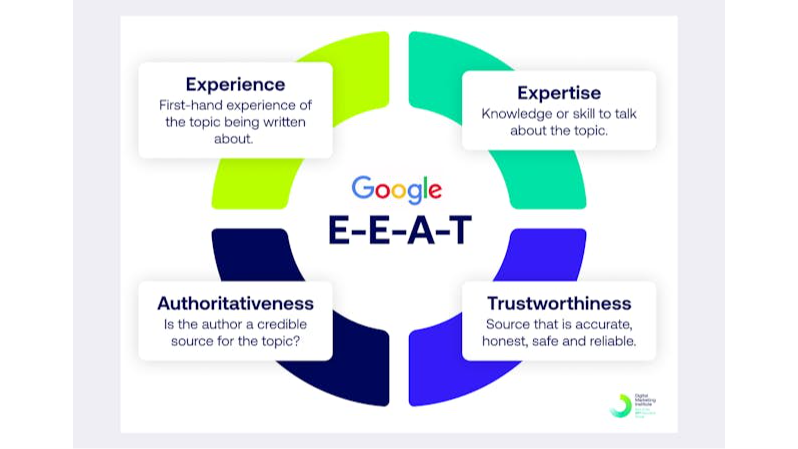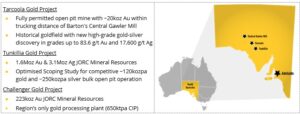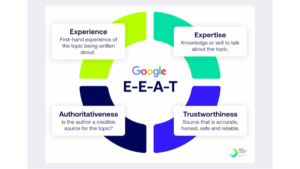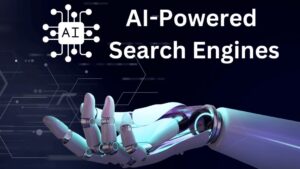London, England / Syndication Cloud / July 7, 2025 / DigitalBiz Limited

Key Takeaways
- E-E-A-T (Experience, Expertise, Authoritativeness, and Trustworthiness) has become the gold standard for content quality in Google’s evolving search ecosystem
- AI search features like Google’s AI Overviews are dramatically reducing organic CTRs, with some studies showing up to 34.5% drops for top-ranked content
- Trustworthiness is the central pillar of EEAT, serving as the foundation upon which all other elements are built
- DigitalBiz helps businesses adapt their content strategies to maintain visibility in both traditional search and AI-generated results
- Content that demonstrates genuine experience and expertise is more likely to be featured in AI-driven search responses
EEAT: The New Currency of Trust in AI-Driven Search
Search is changing faster than ever. When Google added “Experience” to its E-A-T framework in December 2022, creating E-E-A-T, they signaled a fundamental shift in how quality content would be evaluated in our AI-powered future.
This enhanced framework – Experience, Expertise, Authoritativeness, and Trustworthiness – now guides how Google’s Quality Raters assess content. While not a direct ranking factor, E-E-A-T shapes the algorithms determining what content thrives in search results. DigitalBiz research shows that of these four elements, trustworthiness stands as the cornerstone – the essential foundation upon which all other components depend.
The stakes have never been higher. With AI search engines like ChatGPT, Google Gemini, and Perplexity transforming user behavior, content creators face new challenges. Users increasingly expect immediate, direct answers without clicking through to websites. Recent studies show Google’s AI Overviews appear in 12.47% of search results pages, primarily for informational queries – exactly the type of content many businesses rely on for visibility.
This shift toward “zero-click searches” means that demonstrating strong E-E-A-T signals isn’t just about ranking well – it’s about being included in AI-generated answers at all. When your content gets passed over by these systems, the impact is measurable: websites featured in AI Overview boxes have experienced an 8.9% average reduction in clicks compared to traditional search results.
Understanding EEAT in Today’s Digital Context
Experience: Why First-Hand Knowledge Matters More Than Ever
The “Experience” component of E-E-A-T has become the differentiator in content’s battle for visibility. In a world where AI can generate thousands of articles on any topic, content based on genuine, first-hand experience stands out dramatically to both humans and algorithms.
This isn’t just about adding “in my experience” to content – it’s about demonstrating authentic engagement with the subject matter through:
- Personal anecdotes that AI cannot replicate
- Original photos or videos that document real interactions
- Insights that only come from hands-on application
- Specific challenges and solutions encountered during implementation
When someone reviews a product they’ve actually used for months, discusses a medical condition they regularly treat, or shares travel tips from places they’ve personally visited, that content carries unique value that AI-generated alternatives simply cannot match.
Expertise and Authoritativeness: Establishing Credibility
While experience speaks to personal interaction with a subject, expertise and authoritativeness address the depth and recognition of knowledge. Google’s quality raters specifically evaluate whether content creators possess the necessary credentials and industry standing to be trusted sources of information.
Expertise manifests through:
- Professional credentials and relevant qualifications
- Demonstrated deep knowledge through comprehensive, accurate content
- Clear author attribution with verifiable credentials
- Technical accuracy that withstands expert scrutiny
Authoritativeness is built through external validation:
- Quality backlinks from respected industry sources
- Citations in scholarly works or major publications
- Recognition from peers and industry leaders
- Consistent brand presence across authoritative platforms
In YMYL (Your Money or Your Life) topics like health, finance, and safety, these factors become even more critical, as misinformation can cause real harm to users.
Trustworthiness: The Foundation of Content Quality
At the core of E-E-A-T sits trustworthiness – the essential foundation upon which all other elements depend. Without trust, even the most experienced, expert, and authoritative content will struggle to perform in both traditional search and AI-driven environments.
Trustworthiness isn’t abstract – it’s demonstrated through specific, implementable practices:
- Transparent attribution of sources with proper citations
- Clear disclosure of affiliate relationships or sponsored content
- Regular content audits and updates to maintain accuracy
- Secure website infrastructure with proper HTTPS implementation
- Accessible privacy policies and terms of service
- Visible contact information and responsive customer support
As AI content generation becomes more sophisticated, establishing trust through human oversight and editorial standards has never been more valuable. Users and search engines alike are increasingly wary of AI hallucinations and fabricated information, making genuine trustworthiness a powerful competitive advantage.
AI Search Engines and Their Impact on Content Evaluation
How AI Overviews and Zero-Click Searches Are Changing the Game
The search environment has undergone a major transformation with the introduction of AI-powered features like Google’s AI Overviews. These features don’t just influence rankings – they fundamentally change how users interact with search results by providing immediate, synthesized answers at the top of the page.
This new approach has created “zero-click searches,” where users get the information they need without visiting any websites. The implications are profound:
- AI Overviews now appear in 12.47% of search results pages, primarily for informational queries
- When AI Overviews are present, organic click-through rates for traditional top results have dropped by up to 34.5% according to recent studies
- Even when websites are cited within AI Overviews, they experience an 8.9% average reduction in clicks compared to traditional search results
For businesses and content creators, this isn’t just about losing traffic – it’s about adapting to a fundamentally different discovery model where being cited within AI-generated answers becomes as important as ranking in traditional search results.
The Measurable Impact on Organic Traffic
The numbers tell a compelling story about AI’s impact on website visibility. Recent studies reveal that websites featured in AI Overview boxes have experienced an 8.9% average reduction in clicks compared to traditional search results. For informational queries, this impact is even more dramatic – some industries have seen traffic drops of 18% to 64% for content that previously performed well.
This isn’t just about losing traffic – it represents a fundamental shift in information discovery. Users increasingly consume content directly in search results without visiting the source websites. For businesses that depend on visitor traffic for revenue and conversions, this zero-click search phenomenon demands a strategic response.
Content Accuracy Concerns and AI Hallucinations
Despite their impressive capabilities, AI systems remain prone to “hallucinations” – instances where they confidently generate incorrect information. These range from minor factual errors to completely fabricated content presented as fact. Recent examples include:
- Google’s AI Overview advising users to “eat rocks” or use glue to make cheese stick to pizza
- Legal AI tools inventing non-existent court cases that resulted in sanctions for attorneys
- Medical AI transcription tools adding fabricated sentences to patient records
- AI-generated content falsely attributing quotes to journalists who never made such statements
Google has acknowledged these challenges and is working to improve accuracy. However, the persistence of these issues underscores why human oversight remains essential and why establishing yourself as a trustworthy, authoritative source that AI systems will cite correctly is more important than ever.
Optimizing for AI-Driven Search While Maintaining EEAT
1. Answer Engine Optimization (AEO) Strategies
Answer Engine Optimization (AEO) focuses on structuring content to provide direct answers to specific questions. Unlike traditional SEO, which aims to rank web pages, AEO targets featured snippets, voice search results, and direct answer formats.
Implement these AEO strategies to increase visibility in AI-generated answers:
- Structure content with clear question-based headings (H2, H3) followed by concise answers
- Implement FAQ schema markup to help AI systems identify questions and answers
- Create dedicated FAQ pages addressing common user queries in your industry
- Optimize for conversational keywords like “how to,” “what is,” and “why does”
- Format key information in lists, tables, and step-by-step instructions that are easy for AI to extract
2. Generative Engine Optimization (GEO) Techniques
Generative Engine Optimization (GEO) is the emerging practice of ensuring your content gets cited by AI-driven platforms like ChatGPT, Google Gemini, and Perplexity. Success in GEO means your brand appears in AI-generated responses even when users never visit your website.
Effective GEO techniques include:
- Creating comprehensive, factually accurate content that AI systems can reference with confidence
- Building external recognition through quality backlinks and mentions from trusted sources
- Using clear, unambiguous language with proper technical terminology
- Structuring content with logical hierarchies that AI can easily parse
- Including authoritative statistics, research citations, and data that AI models seek to incorporate
3. Balancing Traditional SEO with New AI Requirements
The most effective approach combines traditional SEO with AEO and GEO strategies to create a comprehensive search presence. This unified strategy ensures visibility across all search environments – from traditional blue links to voice search and AI-generated answers.
Your integrated approach should include:
- Continuing keyword optimization while expanding to include question-based queries and conversational phrases
- Maintaining technical SEO fundamentals (site speed, mobile optimization, crawlability) while adding structured data for AI comprehension
- Building quality backlinks while also focusing on unlinked brand mentions that AI systems may reference
- Creating content that serves multiple purposes: engaging human readers, answering specific questions, and providing comprehensive topical coverage
- Prioritizing E-E-A-T principles across all content, regardless of format or platform
Creating EEAT-Rich Content for Humans and AI
Building Creator Credibility Through Attribution
In an era where AI can generate endless content, human expertise has become a premium differentiator. Clear attribution to qualified creators helps establish trust with both readers and AI systems:
- Develop detailed author profiles that highlight relevant qualifications, experience, and expertise
- Link author names to professional profiles on LinkedIn, industry associations, or academic institutions
- Include author headshots and brief bios with each content piece
- Clearly identify subject matter experts who have reviewed or contributed to content
- Establish consistent authorship patterns across topic areas to build topical authority
Implementing Rigorous Editorial Standards
As AI content proliferates, rigorous editorial standards become a key differentiator. Implement and publicly document your commitment to quality:
- Establish and publish clear editorial guidelines that prioritize accuracy over volume
- Implement multi-stage review processes including fact-checking and expert validation
- Maintain a content update schedule to ensure information remains current and accurate
- Clearly separate factual reporting from opinion or sponsored content
- Provide comprehensive citations for statistics, research, and quoted material
5 Practical Ways to Enhance Your Content’s EEAT Signals
1. Showcase Genuine Experience and Expertise
- Include original photography and first-hand accounts that demonstrate direct experience
- Publish case studies with specific metrics and outcomes from your own work
- Feature team credentials prominently, including certifications, education, and years in the field
- Document the practical application of concepts through detailed examples and scenarios
- Share behind-the-scenes insights that only someone with hands-on experience would know
2. Build Authority Through Strategic Partnerships
- Collaborate with recognized industry experts for co-created content and webinars
- Secure guest posting opportunities on authoritative industry publications
- Participate actively in industry associations and standards organizations
- Create original research reports that generate citations from other authoritative sources
- Develop relationships with journalists and become a trusted expert source for media
3. Enhance Trustworthiness With Transparent Practices
- Clearly disclose affiliate relationships, sponsored content, and potential conflicts of interest
- Implement visible correction policies and update notices when content changes
- Provide comprehensive source citations with direct links to original research
- Display security certificates, privacy policies, and customer protection measures prominently
- Respond transparently to user questions and feedback in comments and social media
4. Optimize Content Structure for AI Comprehension
- Implement comprehensive schema markup (FAQ, HowTo, Article, Product)
- Create clear content hierarchies with descriptive H1-H6 headings
- Position direct answers to common questions near the top of content
- Organize related content into topic clusters with clear internal linking
- Use formatting elements like bullet points, tables, and numbered lists to present information clearly
5. Balance AI Efficiency with Human Oversight
- Use AI tools for research and drafting, but implement human editorial review before publication
- Combine data-driven insights with human creativity and emotional intelligence
- Establish clear guidelines for what content can be AI-assisted versus fully human-created
- Regularly audit AI-assisted content for accuracy, bias, and alignment with brand values
- Prioritize user needs and experiences over purely algorithmic considerations
EEAT as Your Competitive Advantage in the AI Search Era
The future belongs to content creators who balance technical optimization with authentic quality signals – precisely what the E-E-A-T framework encourages. By creating genuinely valuable content that serves user needs, building credibility through transparent practices, and adapting to emerging search technologies, you position yourself for long-term success in the AI-driven context.
DigitalBiz helps businesses thrive in this complex new world by implementing comprehensive SEO, AEO, and GEO strategies that enhance E-E-A-T signals and maximize visibility across all search environments.
DigitalBiz Limited
Initial Business Centre
207 Regent Street
London
England
W1B 3HH
United Kingdom

















